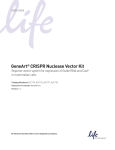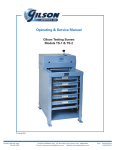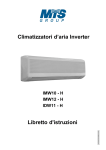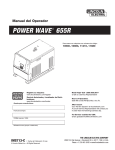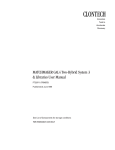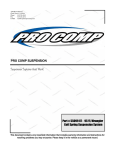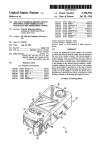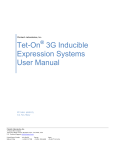Download CLONTECH
Transcript
CLONTECH Innovative Tools to Accelerate Discovery AdvanTAge PCR Cloning Kit User Manual TM PT3067-1 (PR01082) Published 24 March 2000 Catalog #: K1901-1 See List of Components for storage conditions FOR RESEARCH USE ONLY AdvanTAgeTM PCR Cloning Kit User Manual Table of Contents I. Introduction 3 II. List of Components 6 III. Additional Materials Required 8 IV. PCR Amplification 10 V. Cloning into pT-Adv 12 VI. Transformation 14 VII. Troubleshooting Guide 16 VIII. Control Reactions 19 IX. References 24 X. Related Products 25 Appendix: Post-PCR Addition of 3' A-Overhangs 26 List of Figures Figure 1. Flow chart of the AdvanTAge PCR cloning method 4 Figure 2. Restriction map and multiple cloning site of the pT-Adv Vector 5 Notice to Purchaser This product is intended to be used for research purposes only. It is not to be used for drug or diagnostic purposes nor is it intended for human use. CLONTECH products may not be resold, modified for resale, or used to manufacture commercial products without written approval of CLONTECH. The PCR process is covered by patents owned by Hoffmann-La Roche, Inc., and F. Hoffmann-La Roche, A. G. Products covered by U.S. Patents #5,487,993 & #5,827,657 and European Patent #0550693. CLONTECH Laboratories, Inc. 2 www.clontech.com Protocol # PT3067-1 Version # PR01082 AdvanTAgeTM PCR Cloning Kit User Manual I. Introduction The AdvanTAgeTM PCR Cloning Kit provides a quick, simple strategy for directly cloning PCR products. Based on the T/A cloning method (Clark, 1988; Mead et al., 1991), the AdvanTAge kit is optimized to produce >80% recombinants, nine out of 10 of which contain the desired PCR product. The technique requires no special primers (e.g., with added restriction sites), no post-PCR purification, and no enzymatic treatment such as restriction enzyme digestion or polishing to create blunt ends. The AdvanTAge PCR cloning method The AdvanTAge method consists of three main steps (Figure 1). First, ligate your just-amplified PCR product into the pT-Adv Vector. Then, transform the TOP10F' E. coli competent cells provided in the kit and plate onto LB medium containing antibiotic, X-Gal, and IPTG. Finally, select white colonies for further analysis. T/A cloning exploits the terminal transferase activity of thermostable DNA polymerases such as AdvanTaqTM, Taq, or Tth. During PCR, the enzyme adds a single deoxyadenosine (A) to the 3' ends of many reaction products (Clark, 1988). The pT-Adv Vector, with its 3' T-overhangs, enables you to directly clone these products. Because the enzyme’s terminal transferase activity does not depend on the template sequence, essentially any PCR product can be cloned by this method, without prior sequence information or other design constraints. Thermostable polymerases with extensive 3'-to-5' exonuclease (proofreading) activity, such as Vent® and Pfu , do not leave 3' A-overhangs. Even if your PCR application requires Vent or Pfu, or you wish to clone blunt-ended fragments, you may add 3' A-overhangs by incubating with Taq polymerase at the end of your cycling program (see the Appendix). Although CLONTECH’s Advantage® and Advantage® 2 Polymerase Mixes contain a minor amount of proofreading enzyme, PCR products will still have A-overhangs and can be cloned into pT-Adv. The versatile pT-Adv Vector (Figure 2) is manufactured using methods that yield the highest reliability and recombination efficiency. The vector includes priming sites for T7 RNA polymerase, and flanking M13 forward and reverse primer sites for direct sequencing. It also includes a T7 promoter for RNA transcription and translation. A diverse multiple cloning site makes it easy to subclone your PCR product into the expression vector of your choice. In addition, the lacZa gene provides a simple blue/white visual assay for rapid identification of positive clones. Applications The AdvanTAge PCR Cloning Kit makes it easy to clone and characterize products generated using CLONTECH's PCR application kits. For example, after you obtain your full-length cDNA using the MarathonTM cDNA Amplification Kit (#K1802) or SMARTTM RACE cDNA Amplification Kit (#K1811-1), clone it into pT-Adv for further analysis. Similarly, the AdvanTAge Kit can be used to clone differentially expressed genes identified using the CLONTECH PCR-SelectTM cDNA Subtraction Kit (#K1804-1) or ClonCapture TM cDNA Selection Kit (#K1056-1), and amplified using AdvanTaq, AdvanTaq PlusTM, or any Advantage Kit. Protocol # PT3067-1 Version # PR01082 www.clontech.com CLONTECH Laboratories, Inc. 3 AdvanTAgeTM PCR Cloning Kit User Manual I. Introduction continued Unpurified PCR product Ligate into pT-Adv A A T T Plac lacZα Col E1 ori pT-Adv f1 ori 3.9 kb Ampr Kanr Transform TOP10F' cells & plate on LB/X-gal/IPTG with amp or kan Select white colonies for analysis Figure 1. Flow chart of the AdvanTAge PCR cloning method. CLONTECH Laboratories, Inc. 4 www.clontech.com Protocol # PT3067-1 Version # PR01082 AdvanTAgeTM PCR Cloning Kit User Manual I. Introduction continued MCS (234–355) ApaL I (3468) Plac lacZα Col E1 ori f1 ori pT-Adv 3.9 kb Ampr Kan Bgl II r (1259) Sca I (2413) ApaL I (2222) 208 • M13 Reverse Primer GAAACAGCTATGACCATGATTACGCCAAGCTTGGTACCGAGCTCGGATCCACTAGT lacZα START Hind III Kpn I Sac I BamH I Spe I 264 • AACGGCCGCCAGTGTGCTGGAATTCGGCT T EcoR I* BstX I* 309 • PCR Product 3' T-overhang AAGCCGAATTCTGCA EcoR I* GATATCCATCACACTGGCGGCCGCTCGAGCATGCATCTAGAGGGCCCAATTCG Ava I Nsi I Xba I Apa I Not I 362 EcoR V BstX I* 424 Xho I • • CCCTATAGTGAGTCGTATTACAATTCACTGGCCGTCGTTTTACAACGTCGTGACTGGGAAAAC T7 Promoter M13 Sequencing Primer M13 (–40) forward primer Figure 2. Restriction map and multiple cloning site of the pT-Adv vector. Unique restriction sites are in bold. Restriction sites with asterisks (*) are present only in the multiple cloning site (MCS) and can be used to excise the inserted PCR product. The 3' T-overhang preceding the insert is added to the linearized vector during modification. Note that the MCS shown represents the vector sequence after it has been linearized and modified. During preparation, the pT-Adv Vector is modified such that the inserted PCR product is flanked on each side by EcoR I sites. Protocol # PT3067-1 Version # PR01082 www.clontech.com CLONTECH Laboratories, Inc. 5 AdvanTAgeTM PCR Cloning Kit User Manual II. List of Components Store Box 1 at –20°C. Store Box 2 at –70°C. Avoid repeated freeze/thaw cycles. Note: Thermostable DNA polymerase must be supplied by the user. Box 1: AdvanTAge PCR Cloning Reagents • 5 x 10 µl • 10 µl • 10 µl • 10 µl pT-Adv Vector, linearized (25 ng/µl in 10 mM Tris-HCl [pH 7.5], 1 mM EDTA) Control DNA template (0.1 µg/µl in 10 mM Tris-HCl [pH 7.5], 1 mM EDTA) Control Primer 1* (0.1 µg/µl in 10 mM Tris-HCl [pH 7.5], 1 mM EDTA) Control Primer 2* (0.1 µg/µl in 10 mM Tris-HCl [pH 7.5], 1 mM EDTA) *Note: The Control Primers are provided for the PCR Control (Section VIII.C). They are not suitable for sequencing. • 10 µl 50 mM dNTPs (neutralized to pH 8.0) 12.5 mM dATP 12.5 mM dCTP 12.5 mM dGTP 12.5 mM dTTP • 100 µl 10X PCR buffer† 100 mM Tris-HCl (pH 8.3 at 42°C) 500 mM KCl 25 mM MgCl2 0.01% Gelatin † Note: When using CLONTECH's Advantage enzyme mixes, be sure to use the Advantage 10X PCR Buffer. • 25 µl • 100 µl • 1,000 µl T4 DNA ligase (4.0 Weiss units/µl) 10X Ligation buffer 60 mM Tris-HCl (pH 7.5) 60 mM MgCl2 50 mM NaCl 1 mg/ml BSA 70 mM β-mercaptoethanol 1 mM ATP 20 mM Dithiothreitol 10 mM Spermidine Sterile H2O CLONTECH Laboratories, Inc. 6 www.clontech.com Protocol # PT3067-1 Version # PR01082 AdvanTAgeTM PCR Cloning Kit User Manual II. List of Components continued Box 2: Transformation reagents • 6 ml • 21 x 50 µl • 10 µl Protocol # PT3067-1 Version # PR01082 SOC Medium 2% Tryptone 0.5% Yeast extract 10 mM NaCl 2.5 mM KCl 10 mM MgCl2 10 mM MgSO4 20 mM Glucose (dextrose) TOP10F' E. coli competent cells pUC18, supercoiled (control DNA for transformation; 10 ng/µl in 5 mM Tris-HCl, 0.5 mM EDTA) www.clontech.com CLONTECH Laboratories, Inc. 7 AdvanTAgeTM PCR Cloning Kit User Manual III. Additional Materials Required The following materials are required but not supplied: • Ampicillin (50 mg/ml stock) • Kanamycin (50 mg/ml stock) • LB (Luria-Bertani) medium (pH 7.0) 1.0% 0.5% 1.0% for 1 L: 10 g 5 g 10 g Bacto-tryptone Yeast extract NaCl Dissolve ingredients in 950 ml of deionized H2O. Adjust the pH to 7.0 with 5 M NaOH and bring the volume up to 1 L. Autoclave on liquid cycle for 20 min at 15 lb/in2. Store at room temperature or at 4°C. • LB/antibiotic plates Prepare LB medium as above, but add 15 g/L agar before autoclaving. Autoclave on liquid cycle for 20 min at 15 lb/in2. Let cool to ~55°C, add antibiotic (50 µg/ml of either ampicillin or kanamycin), and pour into 10-cm plates. Let harden, then invert and store at 4°C. • X-Gal stock solution (5-bromo-4-chloro-3-indolyl-β-D-galactoside; 40 mg/ml in DMF) Dissolve 400 mg of X-Gal in 10 ml of dimethylformamide. Protect from light by storing in a brown bottle at –20°C. • IPTG stock solution (isopropyl-β-D-thiogalactoside; 100 mM) Dissolve 238 mg of IPTG in 10 ml of deionized H2O. Filter-sterilize and store in 1-ml aliquots at –20°C. • LB/X-Gal/IPTG plates 1. Warm an LB plate containing the appropriate antibiotic at 37°C for 10 min. 2. Pipet 40 µl of the X-Gal stock solution and 40 µl of the IPTG stock solution onto the center of the plate and spread evenly with a sterile spreader. 3. Allow the solution to diffuse into the plate by incubating at 37°C for 20–30 min. CLONTECH Laboratories, Inc. 8 www.clontech.com Protocol # PT3067-1 Version # PR01082 AdvanTAgeTM PCR Cloning Kit User Manual III. Additional Materials Required continued • SOC medium 2% Tryptone 0.5% Yeast Extract 10 mM NaCl 2.5mM KCl 10 mM MgCl2•6H2O 20 mM glucose 1. For 1 liter, dissolve 20 g of tryptone, 5 g of yeast extract, and 0.5 g of NaCl in 950 ml of deionized H2O. 2. Prepare a 250 mM KCl solution by dissolving 1.86 g of KCl in deionized H2O for a total volume of 100 ml. Add 10 ml of this stock KCl solution to the solution prepared in Step 1. 3. Adjust pH to 7.0 with 5 M NaOH, then bring the volume to 980 ml with deionized H2O. 4. Prepare a 1 M solution of MgCl2 by dissolving 20.33 g of MgCl2•6H2O in deionized H2O for a total volume of 100 ml. 5. Autoclave both solutions on liquid cycle at 15 lbs/sq. in. for 20 min. 6. Meanwhile, make a 2 M solution of glucose by dissolving 36 g of glucose in deionized H2O for a total volume of 100 ml. Filter-sterilize this solution. 7. Let the autoclaved solutions cool to about 55°C, then add 10 ml of the filter-sterilized 2 M glucose solution and 10 ml of 1 M MgCl2. Store at room temperature or 4°C. • Terrific Broth 1.2% tryptone 2.4% yeast extract 0.4% glycerol 17mM KH2PO4 72mM K2HPO4 For 1 liter of Terrific Broth: 1. Dissolve 2.31 g of KH2PO4 and 12.54 g of K2HPO4 in 90 ml of deionized H2O. 2. Adjust the volume to 100 ml with deionized H2O. 3. Dissolve 12 g of tryptone, 24 g of yeast extract, and 4 ml of glycerol in 900 ml of deionized H2O. 4. Autoclave both solutions for 20 min on liquid cycle. 5. Cool to ~60°C or less and add the sterile, 100-ml solution of KH2PO4 and K2HPO4 to the tryptone/yeast extract/glycerol solution. Protocol # PT3067-1 Version # PR01082 www.clontech.com CLONTECH Laboratories, Inc. 9 AdvanTAgeTM PCR Cloning Kit User Manual IV. PCR Amplification A. General Considerations • If you are using the AdvanTAge PCR Cloning Kit for the first time, we recommend that you perform the PCR Control in parallel with your experiment. For the PCR Control, use the Control DNA template and Control Primers 1 and 2 provided in the kit. For specific parameters, please see Section VIII.C. • The Control Primers 1 and 2 provided in the kit are intended for use in the PCR Control (Section VIII.C). They are not suitable for sequencing. • You may wish to use a “hot start” for PCR. Hot-start PCR is commonly used to enhance the specificity and sensitivity of PCR amplification (D'Aquila et al., 1991; Chou et al., 1992; Faloona et al., 1990). CLONTECH offers TaqStartTM (#5400-1, -2) and TthStartTM (#5401-1) Antibodies for automatic hot-start PCR. Our AdvanTaq PlusTM DNA Polymerase and all Advantage products provide automatic hot start. • The T/A cloning method works for PCR products generated using any thermostable DNA polymerase that adds 3' A-overhangs. Enzymes with extensive 3'-to-5' exonuclease activity, such as Vent and Pfu , do not leave 3' A-overhangs. Although CLONTECH’s Advantage and Advantage 2 Polymerase Mixes contain a minor amount of proofreading enzyme, PCR products will still have A-overhangs and can be cloned into pT-Adv. However, to maximize your cloning efficiency, you may incubate with Taq polymerase at the end of your cycling program (see the Appendix). If your PCR application requires Vent or Pfu, or you wish to clone bluntended fragments, you may add 3' A-overhangs by incubating with Taq polymerase at the end of your cycling program (see the Appendix). • No modification of your PCR primers (e.g., by phosphorylation or addition of a restriction site) is necessary. B. PCR Amplification In general, 10–100 ng of DNA is sufficient to use as a template for PCR. However, if you are amplifying a pool of cDNA, the amount of template DNA depends on the relative abundance of the message of interest in your mRNA population. For optimal ligation efficiencies, we recommend that you perform no more than 30 PCR cycles. For the PCR Control, use the Control DNA template and Control Primers 1 and 2 provided in the kit. For specific parameters for the PCR Control, please see Section VIII.C. CLONTECH Laboratories, Inc. 10 www.clontech.com Protocol # PT3067-1 Version # PR01082 AdvanTAgeTM PCR Cloning Kit User Manual IV. PCR Amplification continued 1. Prepare a PCR mix for your reactions and controls: per rxn DNA template 10–100 ng 10X PCR buffer 5 µl 50 mM dNTPs 0.5 µl Control Primers 1 & 2 (each) 1 µl Sterile H2O x µl Thermostable DNA polymerase 1 unit Total volume 50 µl 2. Commence cycling in a Perkin-Elmer GeneAmp System 9600 or equivalent thermal cycler. 3. Analyze your PCR product by electrophoresis on an agarose/EtBr gelto confirm that you have obtained a single DNA fragment and to estimate the concentration of your PCR product. Quantify the amount of DNA by measuring against a known standard run on the same gel. The percentage of agarose and the DNA size markers you choose will depend on the expected range of insert sizes. These are general guidelines: Expected size % agarose DNA size markers 0.3–1.5 kb 1.5 φX174/Hae III 0.5–10 kb 1.2 1-kb DNA ladder > 5 kb 0.8 λ/Hind III C. Optimization of PCR If you observe smearing or multiple bands on the agarose/EtBr gel, you must somehow isolate your fragment of interest. Because gel purification may decrease ligation efficiency, we suggest that you attempt to optimize your PCR before resorting to purification. A hot start may help prevent amplification of nonspecific products. For other suggestions, see Innis et al. (1990). If gel purification is necessary, be extremely careful of nuclease contamination. All solutions that come in contact with the gel and fragment should be free of nucleases. Avoid communal EtBr baths and use only high-quality agarose. We have found that either electroelution or silica-based DNA purification systems, such as the NucleoTrap® Gel Extraction Kit (#K30701) or the NucleoSpin® Extraction Kit (#K3051-1, -2) work well. Protocol # PT3067-1 Version # PR01082 www.clontech.com CLONTECH Laboratories, Inc. 11 AdvanTAgeTM PCR Cloning Kit User Manual V. Cloning into pT-Adv A. General Considerations • For optimal ligation efficiencies, we recommend that you use PCR products immediately (< 1 day) after amplification. The single 3' A-overhangs on the PCR products will degrade over time, reducing the efficiency. • The pT-Adv Vector is supplied in five aliquots. It is stable for six months from date of purchase if not subjected to repeated freeze-thaw cycles. Vector that has been stored for longer periods or has been repeatedly frozen and thawed will lose the 3' T-overhangs, resulting in “false” white positives (i.e., background colonies). To confirm that the pT-Adv Vector still has 3' T-overhangs, perform the Self-Ligation Control (Section VIII.A). • Use kanamycin to select transformants when PCR products amplified from ampicillin-resistant plasmids are cloned into pT-Adv. For example, the Control DNA template included in the kit is from an ampicillinresistant plasmid. Selecting with kanamycin will prevent contamination of the transformation reaction by the original ampicillin-resistant plasmid. B. Cloning Procedure 1. Briefly centrifuge one tube of pT-Adv to collect all the liquid in the bottom. 2. Mark the date of first use on the tube. If there is any vector remaining after the experiment, store at –20°C or –70°C. 3. Use the formula below to estimate the amount of PCR product needed to ligate with 50 ng (20 fmol) of pT-Adv: x ng PCR product = (y bp PCR product)(50 ng pT-Adv) (size of pT-Adv: ~3,900 bp) where x ng is the amount of PCR product of y base pairs to be ligated for a 1:1 (vector:insert) molar ratio. Notes: • In general, 0.5 to 1.0 µl of a typical PCR sample with an average insert length of 400– 700 bp will give the proper vector:insert ratio of 1:1. This 1:1 ratio gives the best ligation efficiencies. If you are concerned about the accuracy of your DNA concentrations, try a second ligation reaction at a vector:insert ratio of 1:3. For a 1:3 vector:insert ratio, multiply x by 3 to get the amount of PCR product for ligation. • Do not use more than 2–3 µl of the PCR sample in the ligation reaction because salts in the PCR sample may inhibit the T4 DNA ligase. 4. Calculate the volume of PCR product needed for x ng (determined in step 3). Dilute your PCR sample with sterile H2O if necessary. 5. Set up the ligation reaction as follows: PCR product (< 1 day old) x µl 10X Ligation buffer 1 µl pT-Adv Vector (25 ng/µl) 2 µl Sterile H2O x µl T4 DNA ligase (4.0 Weiss units) 1 µl 10 µl Total volume CLONTECH Laboratories, Inc. 12 www.clontech.com Protocol # PT3067-1 Version # PR01082 AdvanTAgeTM PCR Cloning Kit User Manual V. Cloning into pT-Adv continued 6. Incubate the ligation reaction at 14°C for a minimum of 4 hr (preferably overnight). Higher or lower temperatures may reduce ligation efficiency. 7. Proceed to Transformation (Section VI). If you cannot transform immediately, store your ligation reaction at –20°C until you are ready. Protocol # PT3067-1 Version # PR01082 www.clontech.com CLONTECH Laboratories, Inc. 13 AdvanTAgeTM PCR Cloning Kit User Manual VI. Transformation A. General Considerations • Competent cells are sensitive to temperature and mechanical lysis caused by pipetting. Be extremely gentle! • Start transformation immediately after thawing the cells on ice. Mix any additions by stirring gently with a pipette tip. Keep the cells as cold as possible during all steps. • Use sterile technique when handling and plating your transformations. • TOP10F' expresses the lacZ repressor (LacIq), which will repress transcription from the lac promoter. To perform blue/white screening for inserts, you must add X-Gal and IPTG to your plates to express LacZα. • Use kanamycin to select transformants when PCR products amplified from ampicillin-resistant plasmids are cloned into pT-Adv. For example, the Control DNA template included in the kit is from an ampicillinresistant plasmid. Selecting with kanamycin will prevent contamination of the transformation reaction by the original ampicillin-resistant plasmid. B. Preliminary Steps 1. Equilibrate a water bath to 42°C. 2. Thaw one tube of SOC medium and bring to room temperature. 3. For each ligation/transformation, prepare two LB/X-Gal/IPTG plates containing 50 µg/ml of either ampicillin or kanamycin (plates may be prepared ahead of time). See Section III for recipes. C. Transformation 1. Briefly centrifuge tubes containing the ligation reactions and place them on ice. 2. On ice, thaw one 50-µl tube of frozen TOP10F' E. coli competent cells for each ligation/transformation. 3. Pipet 2 µl of each ligation reaction directly into the competent cells and mix by tapping gently. Do not mix by pipetting up and down. 4. Incubate the tubes on ice for 30 min. Store the remaining ligation mixtures at –20°C. 5. Heat shock for exactly 30 sec in the 42°C water bath. Do not mix or shake. 6. Remove the tubes from the 42°C water bath and place on ice for 2 min. 7. Add 250 µl of SOC medium (at room temperature) to each tube. 8. Shake the tubes horizontally at 37°C for 1 hr at 225 rpm in a rotary shaking incubator. 9. Place the tubes containing the transformed cells on ice. CLONTECH Laboratories, Inc. 14 www.clontech.com Protocol # PT3067-1 Version # PR01082 AdvanTAgeTM PCR Cloning Kit User Manual VI. Transformation continued 10. Spread 50 µl and 200 µl from each transformation on separate, labeled LB/X-Gal/IPTG plates containing 50 µg/ml of either kanamycin or ampicillin. 11. Make sure the liquid is absorbed, then invert the plates and place them in a 37°C incubator for at least 18 hr. 12. Shift plates to 4°C for 2–3 hr to allow proper color development. D. Analysis of Transformation For an insert size of 400–700 bp, you should obtain 50–200 colonies per plate, depending on the volume plated. Approximately 80% of these colonies should be white. Note that ligation efficiency depends on insert size: as insert size increases, the efficiency will decrease. To determine the presence and orientation of insert, analyze DNA by restriction digestion: 1. Pick at least 10 white colonies for plasmid isolation and restriction analysis. 2. Grow colonies overnight in 2–5 ml LB broth containing 50 µg/ml of either ampicillin or kanamycin. 3. Isolate plasmid and analyze by restriction mapping or sequencing for orientation of the insert. For protocols for plasmid isolation and restriction enzyme digestion, please refer to Ausubel et al. (1990) or Sambrook et al. (1989). Note: If you find that putative ampicillin-resistant colonies do not grow in liquid culture containing antibiotic, replate the transformation(s) on plates containing 100 µg/ml ampicillin. To increase plasmid yield, use Terrific Broth or SOC medium containing antibiotic (see Section III for recipes). E. Sequencing Use an M13 reverse primer to sequence into your insert from the lac promoter. To sequence into the insert from the lacZα fragment, you can use either a T7 promoter primer, an M13 (–40) forward primer, or an M13 (–20) forward primer. Please note that commercially available T7 primers do not all have the same sequence. Be sure to check the sequence of your T7 primer carefully (see Figure 2). In addition, if your PCR product was generated using CLONTECH's Marathon cDNA Amplification Kit (#K1802-1), you cannot use a T7 primer to sequence the insert. Protocol # PT3067-1 Version # PR01082 www.clontech.com CLONTECH Laboratories, Inc. 15 AdvanTAgeTM PCR Cloning Kit User Manual VII. Troubleshooting Guide If you do not obtain the results you expect, use the following guide to troubleshoot your experiment. To confirm that your kit is working properly, perform the control reactions (Section VIII). Observation Reason Solution No colonies obtained from transformation Bacteria were not competent. Use the pUC18 vector included with the kit to check transformation efficiency. Plates were too old or contained the wrong concentration of antibiotic. Use 50 µg/ml of either ampicillin or kanamycin. Be sure ampicillin plates are fresh (< 1 month old). White colonies do not have insert The single 3' T-overhangs on the pT-Adv vector may have degraded. Use another tube of pT-Adv. Avoid storing vector for > 6 months or repeatedly freezing and thawing it. Perform the Self-Ligation Control (Section VIII.A) to check vector. Only white colonies obtained Plates lacked X-Gal and/or IPTG. Be sure to include X-Gal and IPTG. Majority of colonies are blue or light blue with very few white colonies The insert did not interrupt the reading frame of the lacZ gene. If your insert is < 500 bp, colonies may be light blue. Check some light blue colonies for insert. A polymerase which does not add 3' A-overhangs, such as Vent or Pfu, was used. Use Taq polymerase. If you must use Vent or Pfu, follow the protocol in the Appendix to add 3' A-overhangs. CLONTECH Laboratories, Inc. 16 www.clontech.com Protocol # PT3067-1 Version # PR01082 AdvanTAgeTM PCR Cloning Kit User Manual VII. Troubleshooting Guide continued Observation Reason Solution Majority of colonies are blue or light blue with very few white colonies (continued) PCR products were gel-purified before ligation. Gel purification can remove the single 3' A-overhangs. Optimize your PCR to avoid gel purification. If gel purification is necessary, use electroelution or a silica matrix-based system. Too much of the amplification reaction was added to the ligation. The high salt content of PCR can inhibit ligation. Use no more than 2–3 µl of the PCR mixture in the ligation reaction. The PCR products were stored for too long before ligation Use PCR products immediately. Efficiencies are reduced after only 1 day of storage. The molar ratio of vector:insert in the ligation reaction was incorrect. Estimate the concentration of the PCR product by agarose gel electrophoresis. Set up the ligation with a 1:1 or 1:3 vector:insert molar ratio. Some colonies have a light blue color or appear white with blue centers There may be leaky expression of the lacZ fragment or only partial disruption of lacZ. If your insert is < 500 bp, check these light blue colonies for insert. White colonies or blue colonies of normal size are surrounded by smaller, white colonies The smaller colonies are ampicillin-sensitive satellites which do not contain plasmid. Do not pick small colonies. Use more ampicillin (up to 100 µg/ml) or use kanamycin. Be sure your ampicillin stock solution and plates are fresh. Protocol # PT3067-1 Version # PR01082 www.clontech.com CLONTECH Laboratories, Inc. 17 AdvanTAgeTM PCR Cloning Kit User Manual VII. Troubleshooting Guide continued Observation Reason Solution White colonies do not grow in liquid culture These colonies may be ampicillin-sensitive satellites. Be sure to pick large white colonies. Use more ampicillin (up to 100 µg/ml) or use kanamycin to eliminate this problem. Be sure ampicillin is fresh. No results from sequencing You accidentally used the Control Primers in the kit for sequencing. These are only suitable for generating the control PCR product. Use the M13 forward (–20 or –40) and reverse primers, or use the T7 promoter primer to sequence into the insert. The sequence of your T7 primer may not have been correct. Check the sequence of your T7 promoter primer and make sure it matches with the priming site on pT-Adv (see Figure 2). You used an SP6 primer for sequencing. Do not use an SP6 primer to sequence pT-Adv. There is no SP6 binding site. No PCR product Either the thermostable DNA polymerase was inactive or the conditions for your PCR were not optimal. Perform the PCR Control (Section VIII.C). If it works, then your polymerase is probably active and you need to optimize your PCR. If it does not work, try new enzyme. Low plasmid yield Cells did not grow well in LB. Try using SOC medium. Remember to include antibiotic. See Section III for recipe. CLONTECH Laboratories, Inc. 18 www.clontech.com Protocol # PT3067-1 Version # PR01082 AdvanTAgeTM PCR Cloning Kit User Manual VIII. Control Reactions Here is a brief overview of the control reactions for troubleshooting AdvanTAge PCR Cloning: Control Reaction Explanation • Self-Ligation Control (Section VIII.A) This control reaction reveals whether pT-Adv has lost the 3' T-overhangs. Loss of the T-overhangs results in blunt-end ligation and disruption of the lacZα reading frame. Many false white colonies will result; normally, < 5% of the colonies should be white. • Transformation Efficiency Control (Section VIII.B) Tests the competency of the TOP10F' E. coli competent cells. There should be 1 x 108 transformants per µg of supercoiled plasmid. • PCR Control (Section VIII.C) Tests the PCR reagents except for the thermostable DNA polymerase. • Ligation/Transformation Control (Section VIII.D) Tests the ligation reagents and pT-Adv. This reaction should produce > 80% white colonies, which should contain vector with insert. A. Self-Ligation Control The pT-Adv Vector is stable for six months from date of purchase if not subjected to repeated freeze-thaw cycles. Vector that has been stored for longer periods or has been repeatedly frozen and thawed will lose the 3' T-overhangs, resulting in “false” white positives (i.e., background colonies). To confirm that the pT-Adv Vector still has the 3' T-overhangs, perform the Self-Ligation Control: a ligation reaction of the pT-Adv Vector alone, followed by transformation into TOP10F' E. coli competent cells. To confirm that the cells are indeed competent, perform the Transformation Efficiency Control (Section VIII.B) alongside the Self-Ligation Control. 1. Combine the following reagents in a sterile 0.5-ml tube: Sterile H2O 6 µl 10X Ligation buffer 1 µl pT-Adv Vector (25 ng/µl) 2 µl T4 DNA ligase (4 Weiss units) 1 µl Total volume 10 µl Protocol # PT3067-1 Version # PR01082 www.clontech.com CLONTECH Laboratories, Inc. 19 AdvanTAgeTM PCR Cloning Kit User Manual VIII. Control Reactions continued 2. Incubate overnight at 14–15°C. 3. Prepare LB/X-Gal/IPTG plates containing 50 µg/ml of either kanamycin or ampicillin (Section III). 4. Briefly centrifuge the tubes containing the ligation reactions and place them on ice. 5. On ice, thaw one 50-µl tube of frozen TOP10F' E. coli competent cells. 6. Pipet 1 µl of the mixture from Step 1 directly into the competent cells and mix by mix by tapping gently. Do not mix by pipetting up and down. 7. Incubate the tube on ice for 30 min. Store the remainder of the ligation reaction mixture at –20°C. 8. Heat shock for exactly 30 sec in the 42°C water bath. Do not mix or shake. 9. Remove the tube from the 42°C water bath and place on ice for 2 min. 10. Add 250 µl of SOC medium (at room temperature) to the tube. 11. Shake the tube horizontally at 37°C for 1 hr at 225 rpm in a rotary shaking incubator. 12. Place the tube with the transformed cells on ice. 13. Spread 50 µl from the tube on a labeled LB/X-Gal/IPTG plate containing 50 µg/ml of either kanamycin or ampicillin. 14. Make sure the liquid is absorbed, then invert the plate and place in a 37°C incubator overnight. Expected Results You should expect about 5–25 colonies from the 50 µl plated. Most of these colonies should be blue; there should be < 5% white colonies. The blue colonies contain supercoiled pT-Adv Vector. Over time, the 3' T-overhangs on the pT-Adv Vector will degrade, causing a blunt-end self-ligation of the vector. This can cause a frameshift of the lacZα gene, resulting in a “false” white or light blue colony with no insert. CLONTECH Laboratories, Inc. 20 www.clontech.com Protocol # PT3067-1 Version # PR01082 AdvanTAgeTM PCR Cloning Kit User Manual VIII. Control Reactions continued B. Transformation Efficiency Control A tube of supercoiled pUC18 is included in the kit as a control for transformation. Before you begin, prepare LB/X-Gal/IPTG plates containing 50 µg/ml ampicillin (see Section III). 1. Dilute the 10 ng/µl stock of pUC18 DNA 1:1,000 in sterile H2O to a final concentration of 10 pg/µl. Keep the 10 pg/µl solution on ice and store the 10 ng/µl stock at –20°C. Discard the diluted solutions when you are finished because the DNA will degrade over time. 2. On ice, thaw one 50-µl tube of frozen TOP10F' E. coli competent cells. 3. Pipet 1 µl of the diluted pUC18 (10 pg/µl) directly into the competent cells and mix by tapping gently. Do not mix by pipetting up and down. 4. Incubate the tube on ice for 30 min. 5. Heat shock for exactly 30 sec in the 42°C water bath. Do not mix or shake. 6. Remove the tube from the 42°C water bath and place on ice for 2 min. 7. Add 250 µl of SOC medium (at room temperature) to the tube. 8. Shake the tube horizontally at 37°C for 1 hr at 225 rpm in a rotary shaking incubator. 9. Place the tube with the transformed cells on ice. 10. Spread 50 µl from the transformation on a labeled LB/X-Gal/IPTG plate containing 50 µg/ml ampicillin. 11. Make sure the liquid is absorbed, then invert the plate and place it in a 37°C incubator overnight. Expected Results The Transformation Control should yield about 100 colonies per 50 µl. The transformation efficiency of the TOP10F' E. coli competent cells is at least 1 x 108 transformants per µg of supercoiled plasmid. Protocol # PT3067-1 Version # PR01082 www.clontech.com CLONTECH Laboratories, Inc. 21 AdvanTAgeTM PCR Cloning Kit User Manual VIII. Control Reactions continued C. PCR Control To test the components of the kit, a control DNA template and primers are included to generate a control PCR product that can be ligated into the pT-Adv Vector. The Control Primers amplify a 700-bp fragment which, when cloned into pT-Adv, will produce about 80% white colonies on LB/XGal/IPTG plates containing 50 µg/ml kanamycin. Because the Control DNA template is from an ampicillin-resistant plasmid, be sure to use kanamycin instead of ampicillin to select transformants. 1. Combine the following reagents in a 0.5-ml PCR tube: Control DNA template (100 ng) 1 µl 10X PCR buffer 5 µl 50 mM dNTPs 0.5 µl Control Primer 1 1 µl Control Primer 2 1 µl Sterile H2O x µl Thermostable DNA polymerase 1 unit Total volume 50 µl 2. Overlay with 70 µl of mineral oil. 3. Commence cycling using the following parameters: • 25 cycles: 94°C 1 min 55°C 1 min 72°C 1 min • 72°C for an additional 7 min after the final cycle 4. Remove 10 µl from the PCR sample and electrophorese on a 0.8–1.5% agarose/EtBr gel. 5. A 700-bp band should be visible. Quantify the amount of DNA by measuring against a known standard run on the same gel. You should get a concentration of about 20 ng/µl for your PCR Control. Proceed to the Ligation/Transformation Control (Section VIII.D). D. Ligation/Transformation Control To test the efficiency of the vector, ligate fresh PCR product into the pT-Adv Vector. In general, 1 µl of the PCR Control (Section VIII.C, above) should be sufficient. Alternatively, you may use the formula given in Section V to estimate the amount of PCR product to ligate with 50 ng of pT-Adv. CLONTECH Laboratories, Inc. 22 www.clontech.com Protocol # PT3067-1 Version # PR01082 AdvanTAgeTM PCR Cloning Kit User Manual VIII. Control Reactions continued 1. Combine the following reagents in a sterile 0.5-ml tube: Sterile H2O 5 µl 10X ligation buffer 1 µl pT-Adv Vector (25 ng/µl) 2 µl Control PCR product 1 µl T4 DNA ligase 1 µl Total volume 10 µl 2. Incubate the Ligation Control at 14°C for a minimum of 4 hr (preferably overnight). 3. Prepare LB/X-Gal/IPTG plates with 50 µg/ml kanamycin for plating the transformation mix from the Ligation Control. (See Section III for recipes.) 4. Briefly centrifuge the Ligation Control reactions and place them on ice. 5. On ice, thaw one 50-µl tube of frozen TOP10F' E. coli competent cells. 6. Pipet 1 µl of the Ligation Control directly into the competent cells and mix by tapping gently. Do not mix by pipetting up and down. 7. Incubate the tube on ice for 30 min. Store the remaining ligation mixture at –20°C. 8. Heat shock for exactly 30 sec in the 42°C water bath. Do not mix or shake. 9. Remove the tube from the 42°C water bath and place on ice for 2 min. 10. Add 250 µl of SOC medium (at room temperature) to each tube. 11. Shake the tubes horizontally at 37°C for 1 hr at 225 rpm in a rotary shaking incubator. 12. Place the transformed cells on ice. 13. Plate 50 µl from the Ligation/Transformation Control on LB/X-Gal/ IPTG plates containing 50 µg/ml kanamycin. 14. Incubate for at least 18 hr at 37°C. Expected Results The Ligation/Transformation Control should produce > 80% white colonies. Over time, the 3' T-overhangs of the pT-Adv Vector will degrade, causing an increase in the number of “false” white colonies (i.e., background colonies without inserts). The background should not exceed 10% (see the Self-Ligation Control, Section VIII.A). If this happens, use another tube of pT-Adv and try to avoid repeated freeze-thaw cycles. Protocol # PT3067-1 Version # PR01082 www.clontech.com CLONTECH Laboratories, Inc. 23 AdvanTAgeTM PCR Cloning Kit User Manual VIII. References Ausubel, F. M., Brent, R., Kingdom, R. E., Moore, D. M., Seidman, J. G., Smith, J. A. & Struhl, K., eds. (1995) Current Protocols in Molecular Biology (John Wiley & Sons, NY). Chou, Q., Russell, M., Birch, D., Raymond, J. & Block, W. (1992) Prevention of pre-PCR mispriming and primer dimerization improves low-copy-number amplifications. Nucleic Acids Res. 20:1717–1723. Clark, J. M. (1988) Novel non-templated nucleotide addition reactions catalyzed by procaryotic and eucaryotic DNA polymerases. Nucleic Acids Res. 16:9677–9686. D'aquila, R. T., Bechtel, L. J., Videler, J. A., Eron, J. J., Gorczyca, P. & Kaplan, J. C. (1991) Maximizing sensitivity and specificity of PCR by preamplification heating. Nucleic Acids Res. 19:3749. Faloona, F., Weiss, S., Ferre, F. & Mullis, K. (1990) Direct detection of HIV sequences in blood: highgain polymerase chain reaction. 6th Int'l Conf. AIDS, San Francisco, CA; Abstr. #1019. Innis, M. A., Gelfand, D. H., Sninsky, J. J. & White, T. J., Eds (1990) PCR Protocols: A Guide to Methods and Applications (Academic Press, Inc., San Diego, CA). Mead, D. A., Pey, N. K., Herrnstadt, C., Marcil, R. A. & Smith, L. M. (1991) A universal method for the direct cloning of PCR amplified nucleic acid Bio/Technology 9:657–663. Sambrook, J., Fritsch, E. F. & Maniatis, T. (1989) Molecular Cloning: A Laboratory Manual, Second Edition (Cold Spring Harbor Laboratory Press, Plainview, New York). CLONTECH Laboratories, Inc. 24 www.clontech.com Protocol # PT3067-1 Version # PR01082 AdvanTAgeTM PCR Cloning Kit User Manual IX. Related Products Product Catalog # • GenomeWalkerTM Kits • ® Advantage 2 PCR Kit K1910-1, -y • ® Advantage 2 Polymerase Mix 8430-1, -2 • AdvanTaqTM DNA Polymerase 8432-1, -2 • AdvanTaq PlusTM DNA Polymerase 8431-1, -2 • AdvanTaq TM many PCR Kit TM K1912-1, -y • AdvanTaq Plus • Advantage®-GC 2 Polymerase Mix 8433-1 • Advantage®-GC 2 PCR Kit K1913-1, -y • PCR Kit K1911-1, -y ® K1914-1, -y ® Advantage -HF 2 PCR Kit • Advantage Genomic PCR Kit K1906-1, -y • Advantage® Genomic Polymerase Mix 8418-1 • TaqStart TM Antibody 5400-1, -2 • TthStart TM Antibody TM 5401-1 • Marathon • Marathon-ReadyTM cDNAs many • SMART TM RACE cDNA Amplification Kit #K1811-1 • cDNA Amplification Kit CLONTECH PCR-Select TM cDNA Subtraction Kit TM K1802-1 K1804-1 • Delta Differential Display Kit K1810-1 • ClonCaptureTM cDNA Selection Kit K1056-1 • Ligation ExpressTM Kit K1049-1 Protocol # PT3067-1 Version # PR01082 www.clontech.com CLONTECH Laboratories, Inc. 25 AdvanTAgeTM PCR Cloning Kit User Manual Appendix: Post-PCR Addition of 3' A-Overhangs It is often difficult to directly clone DNA amplified by Vent or Pfu polymerases into pT-Adv. Low cloning efficiencies are caused by the 3'-to-5' exonuclease proofreading activities of Vent and Pfu polymerases, which remove the 3' A-overhangs necessary for T/A cloning. The following protocol for adding 3' A-overhangs to blunt-ended PCR products makes it possible to clone these products: 1. After amplification with Vent or Pfu polymerase, place tubes on ice and add 0.7–1 unit of Taq polymerase to each tube. Mix well. It is not necessary to change the buffer. 2. Incubate at 72°C for 8–10 min (do not cycle). 3. Extract immediately with an equal volume of phenol:chloroform. 4. Add 1/10 volume of 3 M sodium acetate and 2X volume of 100% ethanol. 5. Centrifuge at maximum speed for 5 min at room temperature to precipitate the DNA. 6. Remove the ethanol, rinse the pellet with 80% ethanol, and allow to air dry. 7. Resuspend the pellet in TE buffer to the starting volume of the DNA amplification reaction. The DNA amplification product is now ready for ligation into the pT-Adv Vector. CLONTECH Laboratories, Inc. 26 www.clontech.com Protocol # PT3067-1 Version # PR01082 AdvanTAgeTM PCR Cloning Kit User Manual Notes: AdvanTAgeTM , AdvanTaqTM, AdvanTaq PlusTM , ClonCaptureTM, CLONTECH PCR-SelectTM , DeltaTM , GenomeWalkerTM , MarathonTM, Marathon-ReadyTM, SMARTTM , TaqStartTM, and TthStartTM are trademarks of CLONTECH Laboratories, Inc. Advantage® is a registered trademark of CLONTECH Laboratories, Inc. GeneAmp® is a registered trademark of Roche Molecular Systems, Inc., licensed to the PerkinElmer Corporation. Vent ® is a registered trademark of New England Biolabs. The PCR process is covered by patents owned by Hoffmann-La Roche, Inc., and F. HoffmannLa Roche Ltd. © 1999, CLONTECH Laboratories, Inc. Protocol # PT3067-1 Version # PR01082 www.clontech.com CLONTECH Laboratories, Inc. 27






































